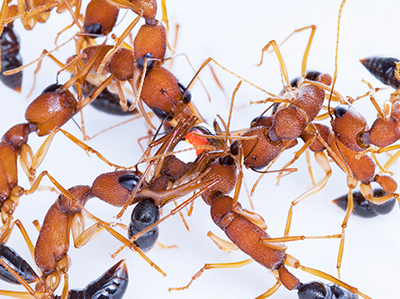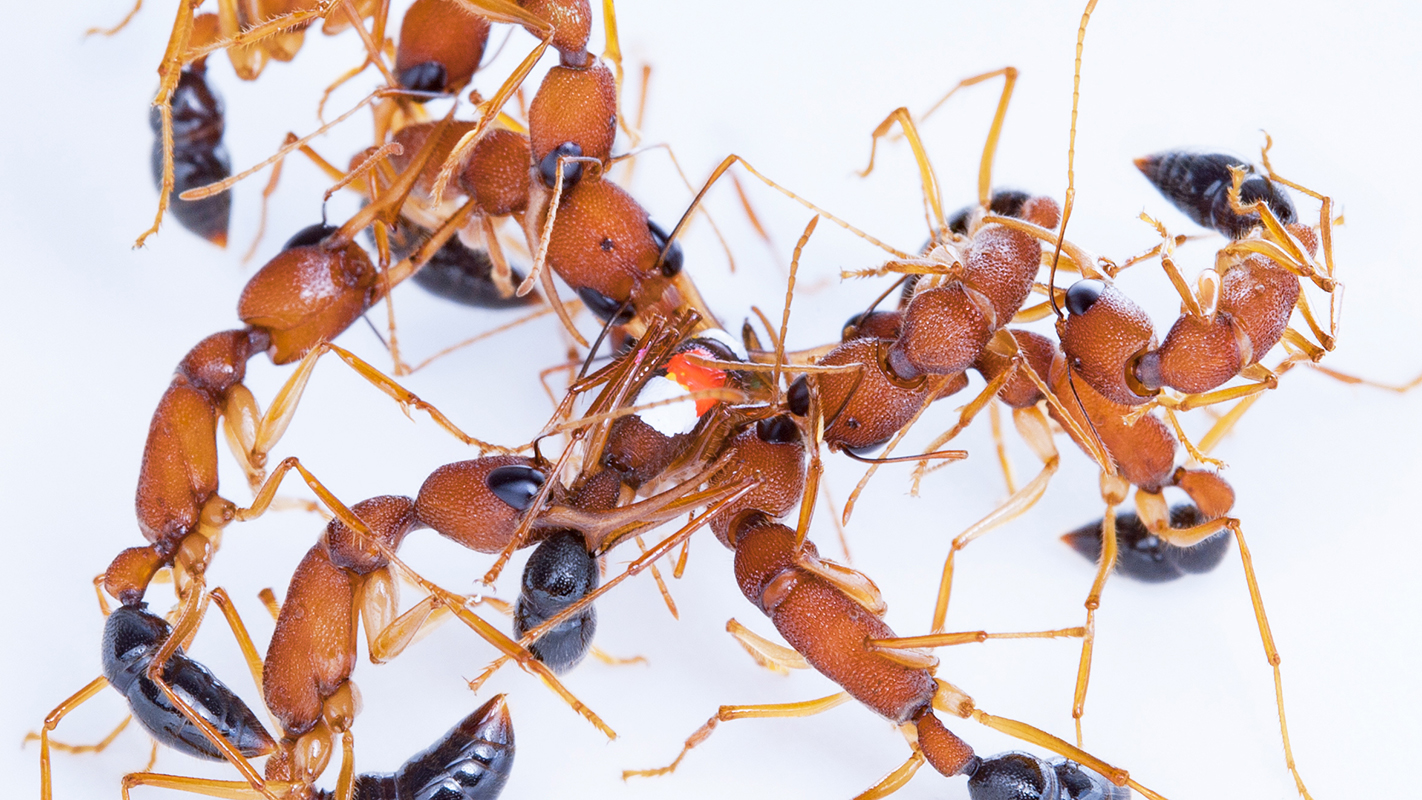For Immediate Release
Researchers have developed a behavioral model that explains the complexity and diversity of social hierarchies in ants, and which scientists believe may help us understand the nature of other animal societies – from primates to dolphins. The work was done by researchers at North Carolina State University, the University of Oxford and Arizona State University.

“Earlier research on animal hierarchies has focused almost exclusively on behaviors that have a clear winner and loser, because this is how a single individual can establish dominance,” says Clint Penick, a postdoctoral researcher at NC State and co-lead author of a paper on the work. “But this doesn’t help us understand animal societies where there is a group of dominant individuals rather than a single ‘alpha.’ We think that some dominance behaviors are actually winner-winner interactions, increasing the social authority or standing of both participants.”
The researchers began by examining the behaviors and social hierarchy of the well-studied Indian jumping ant (Harpegnathos saltator). When an H. saltator colony’s queen dies, the female workers engage in ritual fights to establish dominance. While these battles can be fierce, they rarely result in physical injury to the workers. Ultimately, a group of approximately 10 workers will establish dominance and become a cadre of worker queens or “gamergates.”
A social hierarchy like that seen with H. saltator’s gamergates is called a shared dominance hierarchy. Most of other ant societies establish despotic hierarchies or linear hierarchies. In a despotic hierarchy, one individual is dominant and all other individuals share the same subordinate status. In a linear hierarchy, there is a clear pecking order: there is a dominant alpha, a beta who is dominant over all but the alpha, a gamma who is dominant over all but the alpha and beta, and so on.

The researchers identified three behaviors related to establishing a hierarchy in H. saltator: biting, in which one ant bites another’s head, has a clear winner and loser, with the winner establishing dominance; policing, in which subordinate workers restrain challengers to a dominant individual; and dueling, in which two individuals engage in a martial display with their antennae, but which has no clear loser.
“We were curious as to whether dueling results in a winner and a loser, or if it is a winner-winner interaction that allows workers to express aggression without requiring a loser,” says Jürgen Liebig, an associate professor at Arizona State University who is senior author on the study. Penick adds that dueling may be like, “a couple of football players psyching each other up before a game.”
To explore this question, the researchers created a computer model that allowed them to manipulate all three behaviors in order to see how the behaviors affected the social structure of a colony.
When biting was present, but policing and dueling were absent, the model resulted in a linear hierarchy. When biting and strong policing were present, the model resulted in a despotic hierarchy with a single dominant individual. It was only when biting, policing and winner-winner dueling were all present that the model resulted in a shared dominance hierarchy.
“We see examples of all three types of social hierarchies in various ant species, but we also see them throughout the animal kingdom – and we know that shared dominance hierarchies can be found in animal societies from lions to dolphins,” Penick says. “Higher cognition certainly plays a role in shaping the societies of many vertebrates, but we think the presence or absence of winner-winner behaviors may be an important factor in determining the nature of dominance hierarchies for a wide variety of species.”
The paper, “A simple behavioral model predicts the emergence of complex animal hierarchies,” is published in the journal The American Naturalist. Co-lead author of the paper is Takao Sasaki of Oxford. The paper was co-authored by Zachary Shaffer, Kevin Haight, Stephen Pratt and Jürgen Liebig of Arizona State. The work was supported by the National Science Foundation under grant number 1012029.
-shipman-
Note to Editors: The study abstract follows.
“A simple behavioral model predicts the emergence of complex animal hierarchies”
Authors: Takao Sasaki, University of Oxford; Clint A. Penick, North Carolina State University; Zachary Shaffer, Kevin L. Haight, Stephen C. Pratt and Jürgen Liebig, Arizona State University
Published: April 14, The American Naturalist
DOI: 10.1086/686259
Abstract: Social dominance hierarchies are widespread, but little is known about the mechanisms that produce non-linear structures. In addition to despotic hierarchies, where a single individual dominates, shared hierarchies exist where multiple individuals occupy a single rank. In vertebrates, these complex dominance relationships are thought to develop from interactions that require higher cognition, but similar cases of shared dominance have been found in social insects. Combining empirical observations with a modeling approach, we show that all three hierarchy structures–linear, despotic, and shared–can emerge from different combinations of simple interactions present in social insects. Our model shows that a linear hierarchy emerges when a typical winner-loser interaction (dominance biting) is present. A despotic hierarchy emerges when a policing interaction is added that results in the complete loss of dominance status for an attacked individual (physical policing). Finally, a shared hierarchy emerges with the addition of a “winner-winner” interaction that results in a positive outcome for both interactors (antennal dueling). Antennal dueling is an enigmatic ant behavior that has previously lacked a functional explanation. These results show how complex social traits can emerge from simple behaviors without requiring advanced cognition.
- Categories:



